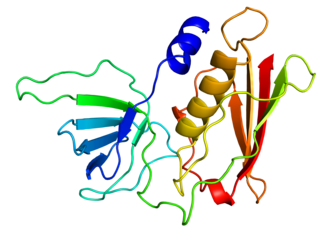DNA-binding protein RFX5 is a protein that in humans is encoded by the RFX5 gene. [3] [4]
DNA-binding protein RFX5 is a protein that in humans is encoded by the RFX5 gene. [3] [4]
A lack of MHC-II expression results in a severe immunodeficiency syndrome called MHC-II deficiency, or the bare lymphocyte syndrome (BLS; MIM 209920). At least 4 complementation groups have been identified in B-cell lines established from patients with BLS. The molecular defects in complementation groups B, C, and D all lead to a deficiency in RFX, a nuclear protein complex that binds to the Xbox of MHC-II promoters. The lack of RFX binding activity in complementation group C results from mutations in the RFX5 gene encoding the 75-kD subunit of RFX (Steimle et al., 1995). RFX5 is the fifth member of the growing family of DNA-binding proteins sharing a novel and highly characteristic DNA-binding domain called the RFX motif. Multiple alternatively spliced transcript variants have been found but the full-length natures of only two have been determined. [4]

In immunology, an antigen (Ag) is a molecule, moiety, foreign particulate matter, or an allergen, such as pollen, that can bind to a specific antibody or T-cell receptor. The presence of antigens in the body may trigger an immune response.
A class II gene is a type of gene that codes for a protein. Class II genes are transcribed by RNAP II.

GATA-binding factor 1 or GATA-1 is the founding member of the GATA family of transcription factors. This protein is widely expressed throughout vertebrate species. In humans and mice, it is encoded by the GATA1 and Gata1 genes, respectively. These genes are located on the X chromosome in both species.

Bare lymphocyte syndrome type II is a rare recessive genetic condition in which a group of genes called major histocompatibility complex class II are not expressed. The result is that the immune system is severely compromised and cannot effectively fight infection.

Bare lymphocyte syndrome is a condition caused by mutations in certain genes of the major histocompatibility complex or involved with the processing and presentation of MHC molecules. It is a form of severe combined immunodeficiency.

MHC Class II molecules are a class of major histocompatibility complex (MHC) molecules normally found only on professional antigen-presenting cells such as dendritic cells, mononuclear phagocytes, some endothelial cells, thymic epithelial cells, and B cells. These cells are important in initiating immune responses.

CIITA is a human gene which encodes a protein called the class II, major histocompatibility complex, transactivator. Mutations in this gene are responsible for the bare lymphocyte syndrome in which the immune system is severely compromised and cannot effectively fight infection. Chromosomal rearrangement of CIITA is involved in the pathogenesis of Hodgkin lymphoma and primary mediastinal B cell lymphoma.

Toxic shock syndrome toxin-1 (TSST-1) is a superantigen with a size of 22 kDa produced by 5 to 25% of Staphylococcus aureus isolates. It causes toxic shock syndrome (TSS) by stimulating the release of large amounts of interleukin-1, interleukin-2 and tumour necrosis factor. In general, the toxin is not produced by bacteria growing in the blood; rather, it is produced at the local site of an infection, and then enters the blood stream.

Nuclear transcription factor Y subunit beta is a protein that in humans is encoded by the NFYB gene.

MHC class II regulatory factor RFX1 is a protein that, in humans, is encoded by the RFX1 gene located on the short arm of chromosome 19.

DNA-binding protein RFXANK is a protein that in humans is encoded by the RFXANK gene.

Regulatory factor X-associated protein is a protein that in humans is encoded by the RFXAP gene.

AT-rich interactive domain-containing protein 2 (ARID2) is a protein that in humans is encoded by the ARID2 gene.

DNA-binding protein RFX2 is a protein that in humans is encoded by the RFX2 gene.

Transcription factor RFX4 is a protein that in humans is encoded by the RFX4 gene.

HLA class II histocompatibility antigen, DX beta chain is a protein that in humans is encoded by the HLA-DQB2 gene.

Transcriptional repressor NF-X1 is a protein that in humans is encoded by the NFX1 gene.

Transcription factor RFX3 is a protein that in humans is encoded by the RFX3 gene.

The Emberger syndrome is a rare, autosomal dominant, genetic disorder caused by familial or sporadic inactivating mutations in one of the two parental GATA2 genes. The mutation results in a haploinsufficiency in the levels of the gene's product, the GATA2 transcription factor. This transcription factor is critical for the embryonic development, maintenance, and functionality of blood-forming, lympathic-forming, and other tissues. The syndrome includes as its primary symptoms: serious abnormalities of the blood such as the myelodysplastic syndrome and acute myeloid leukemia; lymphedema of the lower limbs, and sensorineural hearing loss. However, the anomalies caused by GATA2 mutations are highly variable with some individuals showing little or no such symptoms even in old age while others exhibit non-malignant types of hematological anomalies; lymphedema in areas besides the lower limbs, little or no hearing loss; or anomalies in other tissues. The syndrome may present with relatively benign signs and/or symptoms and then progress rapidly or slowly to the myelodysplastic syndrome and/or acute myeloid leukemia. Alternatively, it may present with one of the latter two life-threatening disorders.
This article incorporates text from the United States National Library of Medicine, which is in the public domain.